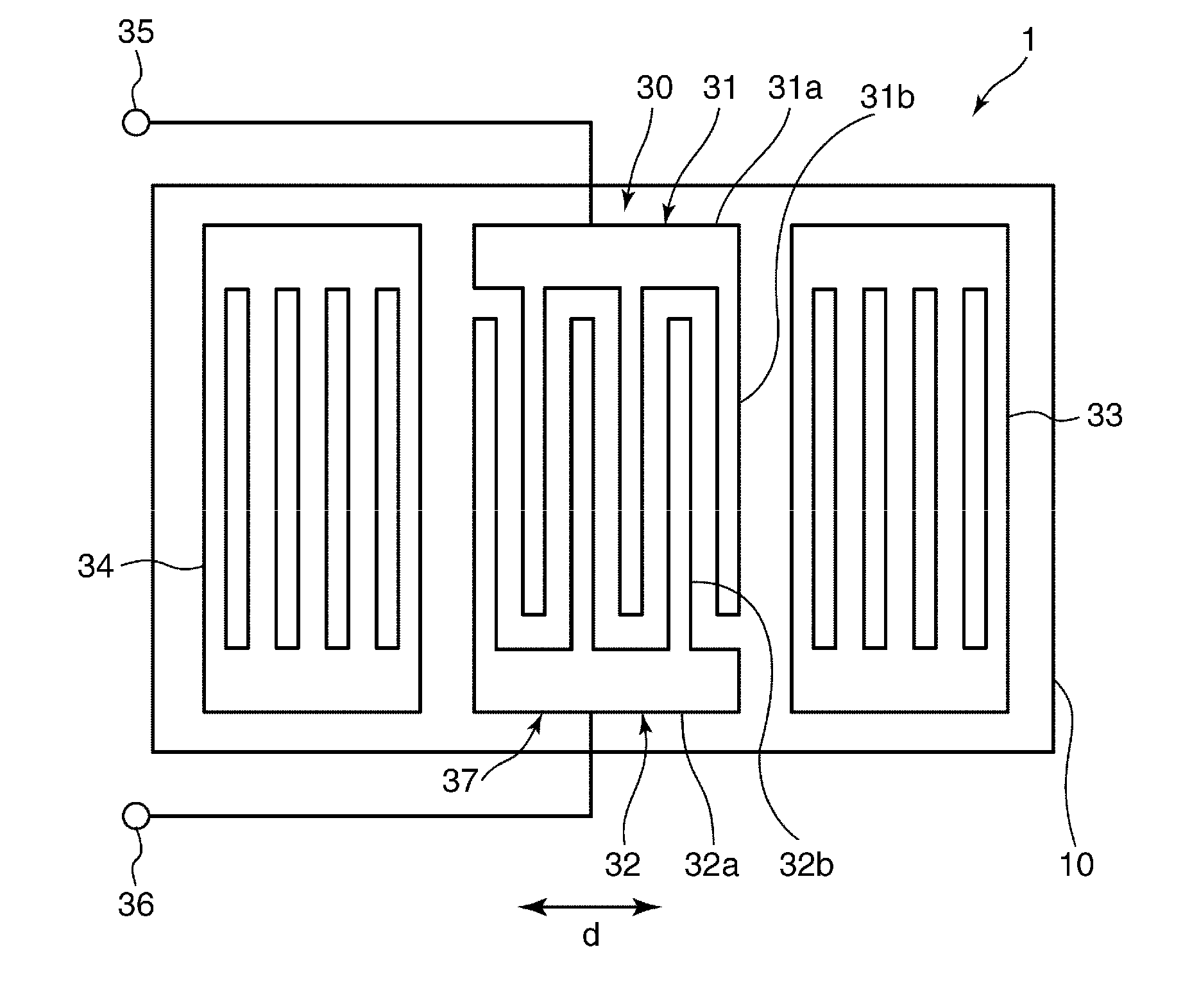Elastic wave device
a technology of elastic wave and electrode finger, which is applied in the direction of piezoelectric/electrostrictive/magnetostrictive devices, piezoelectric/electrostriction/magnetostriction machines, etc., can solve the problems of disadvantageously reducing the pitch of the electrode finger of the idt electrode, and reducing the insertion loss. , to achieve the effect of reducing the insertion loss, reducing the s
- Summary
- Abstract
- Description
- Claims
- Application Information
AI Technical Summary
Benefits of technology
Problems solved by technology
Method used
Image
Examples
example 1
CONDITIONS IN EXAMPLE 1
[0079]Piezoelectric component 10: LiTaO3 substrate defined by Euler angles (0°, 128°, 0°)[0080]Thickness (mm) of piezoelectric component 10: 0.38[0081]First electrode layer 21: Pt film[0082]Wavelength-normalized thickness (h / λ) of first electrode layer 21: 0.03[0083]Second electrode layer 22: Al film[0084]Wavelength-normalized thickness (h / λ) of second electrode layer 22: 0.04[0085]Dielectric layer 20: SiO2 layer
[0086]In Comparative Example 1, surface acoustic wave devices as illustrated in FIG. 3 were produced under the same conditions as those in Example 1, except that both the first and second electrode layers 21 and 22 were formed in the grooves 10a of the piezoelectric component 10. The reflection coefficients of the surface acoustic wave devices including the dielectric layers 20 having different thicknesses were measured. The measurement results of the reflection coefficients are indicated by a broken line in a graph shown in FIG. 4.
[0087]In Example 2, ...
example 2
CONDITIONS IN EXAMPLE 2
[0088]Piezoelectric component 10: LiTaO3 substrate defined by Euler angles (0°, 216°, 0°)[0089]Thickness (mm) of piezoelectric component 10: 0.38[0090]First electrode layer 21: Pt film[0091]Wavelength-normalized thickness (h / λ) of first electrode layer 21: 0.03[0092]Second electrode layer 22: Al film[0093]Wavelength-normalized thickness (h / λ) of second electrode layer 22: 0.04[0094]Dielectric layer 20: SiO2 layer
[0095]In Comparative Example 2, surface acoustic wave devices as illustrated in FIG. 3 were produced under the same conditions as those in Example 2, except that both the first and second electrode layers 21 and 22 were formed in the grooves 10a of the piezoelectric component 10. The reflection coefficients of the surface acoustic wave devices including the dielectric layers 20 having different thicknesses were measured. The measurement results of the reflection coefficients are indicated by a broken line in a graph shown in FIG. 6.
[0096]As illustrated...
example 3
CONDITIONS IN EXAMPLE 3
[0101]Piezoelectric component 10: LiTaO3 substrate defined by Euler angles (0°, 128°, 0°)[0102]Thickness (mm) of piezoelectric component 10: 0.38[0103]First electrode layer 21: Pt film[0104]Second electrode layer 22: Al film[0105]Dielectric layer 20: SiO2 layer[0106]Wavelength-normalized thickness (h / λ) of dielectric layer 20: 0.25
PUM
 Login to View More
Login to View More Abstract
Description
Claims
Application Information
 Login to View More
Login to View More - R&D
- Intellectual Property
- Life Sciences
- Materials
- Tech Scout
- Unparalleled Data Quality
- Higher Quality Content
- 60% Fewer Hallucinations
Browse by: Latest US Patents, China's latest patents, Technical Efficacy Thesaurus, Application Domain, Technology Topic, Popular Technical Reports.
© 2025 PatSnap. All rights reserved.Legal|Privacy policy|Modern Slavery Act Transparency Statement|Sitemap|About US| Contact US: help@patsnap.com



